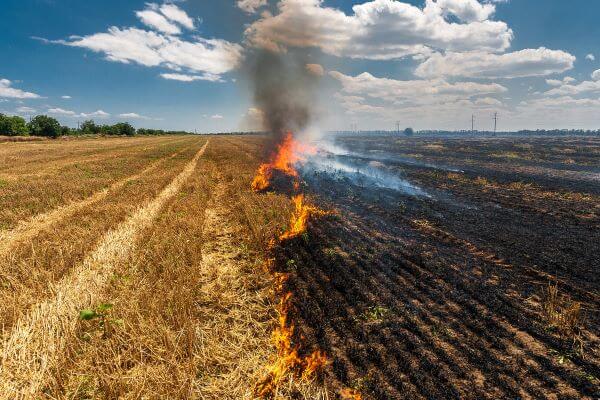Why your fire risk assessment should include the threat to crops

Fire is always considered as a risk for rural property and machinery, but it can also be one of the greatest risks for arable farmers.
A fire can quickly wipe out a year’s income if it spreads through fields quickly and is an even more significant risk following harvest if crops are stored in barns or other out-buildings.
The UK has also experienced several heatwaves in recent years, with global warming almost certainly playing a part.
Here at A-Plan Rural, 33 per cent of our farming claims are fire related and crop damage should certainly be included in any risk assessment.
A robust risk assessment can help prevent fires and keep people safe. And with the right insurance, it is possible for farmers with businesses of all sizes to recover their lost revenue following a fire.
Crops stored after harvest are at the greatest risk, but basic steps can be taken to prevent stored crops from combusting.
This includes:
Providing adequate ventilation in storage facilities such as barnsSacking straw properly.Installing a regularly-maintained fire extinguisher on all machinery, including combines.Identifying water sources so you know where to turn in case of a fireDuring harvesting, being prepared to cut fire breaks by keeping appropriate cultivators hitched to nearby tractors. Remember that fire can be unpredictable and can change direction quickly when you are cutting breaks.
Another key risk is arson.
Farmers should consider whether vandalism or fires are a problem near their land and take steps to reduce the likelihood of being targeted, such as removing hay and straw from the field immediately after harvesting and storing it away from buildings that house flammable chemicals or livestock.
Fuels, fertilisers and pesticides should be securely stored, refuse should be disposed of regularly, and farm buildings should be fitted with security features like intruder alarms.
Fire risk assessment
A fire risk assessment will help keep people, livestock and crops safe, and The Regulatory Reform Fire Safety Order 2005 requires all farms to have one in place. The legislation applies to all farm buildings where people work.
Steps to take include:
Identify hazards, including any flammable material such as hay, fuel and fertilisersIdentify people at risk, including employees, visitors and fire fighters.Evaluate the risk of fireRecord significant findings and actions takenReview the assessment regularly
Businesses which who employ five or more people are required by law to record significant findings.
These steps will help to protect a farm and the people on it; however, it is also equally important to protect income through insurance. A broker should be able to provide guidance and peace of mind that, should the worst happen, lost revenue will be recovered.
Insurance considerations
It is possible to buy standalone crop insurance. However, insuring the potential revenue is the most effective way in which to mitigate a potential loss.
Often referred to as “Loss of Revenue” in a farm policy, the cover ensures that an insurance pay-out is for the full potential value. Loss of revenue covers crops from seed to store, so the full value of the crop is protected until it reaches the haulage stage. This means revenue is protected, whether there has been a fire in the store, a combine fire or arson in the field.
This type of insurance gives the best chance of protecting a year’s hard work, with farmers trusted as the best authority on their expected turnover.
For more information visit www.aplan.co.uk/rural.







